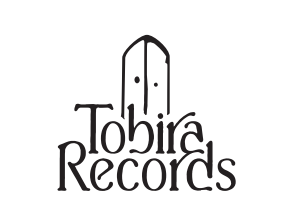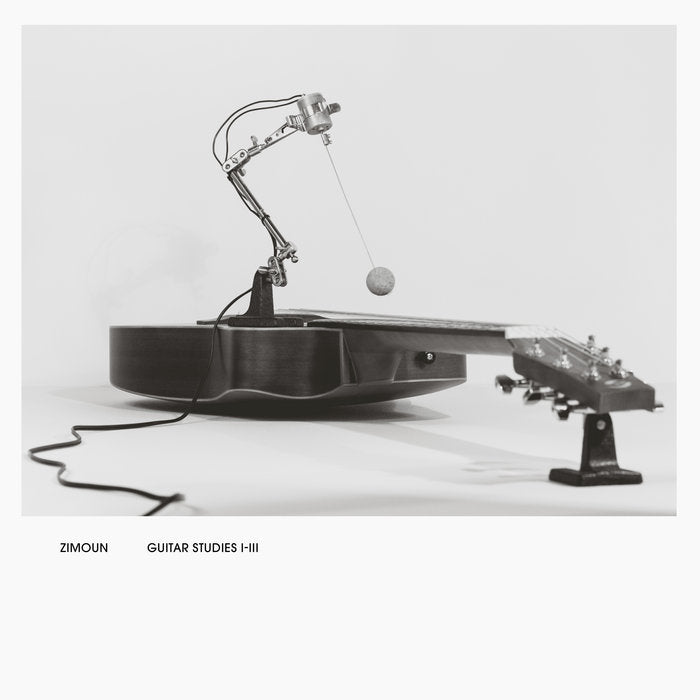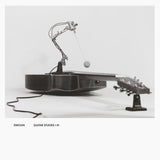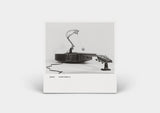クイックビュー
{"id":9001164964090,"title":"Alister Spence \/\/ Within Without CD","handle":"alister-spence-within-without-cd","description":"\u003cp\u003eオーストラリア・シドニーのピアニストAlister Spence\u003cspan\u003eが、2025年10月にブリスベンの音響作家Lawrence English主宰レーベルRoom40からリリースしたCDです。\u003c\/span\u003e\u003c\/p\u003e\n\u003cp\u003e\u003cspan\u003eRhodesをメインソースにしたアンビエント〜アンビエント・ジャズ18曲を収録。\u003c\/span\u003e\u003c\/p\u003e\n\u003cp\u003e\u003ciframe src=\"https:\/\/bandcamp.com\/EmbeddedPlayer\/album=2334628490\/size=large\/bgcol=ffffff\/linkcol=0687f5\/tracklist=false\/artwork=none\/track=3721452460\/transparent=true\/\" style=\"border: 0; width: 100%; height: 120px;\"\u003e\u003c\/iframe\u003e\u003c\/p\u003e\n\u003cp\u003e\u003ciframe style=\"border: 0; width: 100%; height: 120px;\" src=\"https:\/\/bandcamp.com\/EmbeddedPlayer\/album=2334628490\/size=large\/bgcol=ffffff\/linkcol=0687f5\/tracklist=false\/artwork=none\/transparent=true\/\"\u003e\u003c\/iframe\u003e\u003c\/p\u003e\n\u003cp\u003eレーベルその他作品は\u003ca href=\"https:\/\/tobirarecords.com\/collections\/room40\"\u003eこちら\u003c\/a\u003e\u003cspan\u003e \u003c\/span\u003e\/\/\/ Click \u003ca href=\"https:\/\/tobirarecords.com\/collections\/room40\"\u003ehere\u003c\/a\u003e to see more Room40 releases available at Tobira.\u003c\/p\u003e\n\u003cp\u003e---------------------------------------\u003c\/p\u003e\n\u003cp\u003eCD in matt laminate cardstock sleeve. \u003c\/p\u003e\n\u003cp\u003e\u003cstrong\u003eTracklist\u003c\/strong\u003e:\u003c\/p\u003e\n\u003cp class=\"MsoNormal\"\u003e1. Hungry Machine 00:45\u003cbr\u003e\u003cspan style=\"font-family: -apple-system, BlinkMacSystemFont, 'San Francisco', 'Segoe UI', Roboto, 'Helvetica Neue', sans-serif; font-size: 0.875rem;\"\u003e2. Breath Formation 01:42\u003cbr\u003e\u003c\/span\u003e\u003cspan style=\"font-family: -apple-system, BlinkMacSystemFont, 'San Francisco', 'Segoe UI', Roboto, 'Helvetica Neue', sans-serif; font-size: 0.875rem;\"\u003e3. Meaning and Mechanics 06:34\u003cbr\u003e\u003c\/span\u003e\u003cspan style=\"font-family: -apple-system, BlinkMacSystemFont, 'San Francisco', 'Segoe UI', Roboto, 'Helvetica Neue', sans-serif; font-size: 0.875rem;\"\u003e4. Sounding for Sound 07:21\u003cbr\u003e\u003c\/span\u003e\u003cspan style=\"font-family: -apple-system, BlinkMacSystemFont, 'San Francisco', 'Segoe UI', Roboto, 'Helvetica Neue', sans-serif; font-size: 0.875rem;\"\u003e5. Delicate Industry 02:28\u003cbr\u003e\u003c\/span\u003e\u003cspan style=\"font-family: -apple-system, BlinkMacSystemFont, 'San Francisco', 'Segoe UI', Roboto, 'Helvetica Neue', sans-serif; font-size: 0.875rem;\"\u003e6. Metal Spectral 01:30\u003cbr\u003e\u003c\/span\u003e\u003cspan style=\"font-family: -apple-system, BlinkMacSystemFont, 'San Francisco', 'Segoe UI', Roboto, 'Helvetica Neue', sans-serif; font-size: 0.875rem;\"\u003e7. Cheery Buzzy 01:36\u003cbr\u003e\u003c\/span\u003e\u003cspan style=\"font-family: -apple-system, BlinkMacSystemFont, 'San Francisco', 'Segoe UI', Roboto, 'Helvetica Neue', sans-serif; font-size: 0.875rem;\"\u003e8. Tremble, Rattle 01:34\u003cbr\u003e\u003c\/span\u003e\u003cspan style=\"font-family: -apple-system, BlinkMacSystemFont, 'San Francisco', 'Segoe UI', Roboto, 'Helvetica Neue', sans-serif; font-size: 0.875rem;\"\u003e9. Bright Welcome 02:09\u003cbr\u003e\u003c\/span\u003e\u003cspan style=\"font-family: -apple-system, BlinkMacSystemFont, 'San Francisco', 'Segoe UI', Roboto, 'Helvetica Neue', sans-serif; font-size: 0.875rem;\"\u003e10. Interior Signal 02:11\u003cbr\u003e\u003c\/span\u003e\u003cspan style=\"font-family: -apple-system, BlinkMacSystemFont, 'San Francisco', 'Segoe UI', Roboto, 'Helvetica Neue', sans-serif; font-size: 0.875rem;\"\u003e11. Obscure Message 04:51\u003cbr\u003e\u003c\/span\u003e\u003cspan style=\"font-family: -apple-system, BlinkMacSystemFont, 'San Francisco', 'Segoe UI', Roboto, 'Helvetica Neue', sans-serif; font-size: 0.875rem;\"\u003e12. Middle Distance 03:29\u003cbr\u003e\u003c\/span\u003e\u003cspan style=\"font-family: -apple-system, BlinkMacSystemFont, 'San Francisco', 'Segoe UI', Roboto, 'Helvetica Neue', sans-serif; font-size: 0.875rem;\"\u003e13. Clang, Re-sound 01:40\u003cbr\u003e\u003c\/span\u003e\u003cspan style=\"font-family: -apple-system, BlinkMacSystemFont, 'San Francisco', 'Segoe UI', Roboto, 'Helvetica Neue', sans-serif; font-size: 0.875rem;\"\u003e14. Growl, Warble, Strike 05:50\u003cbr\u003e\u003c\/span\u003e\u003cspan style=\"font-family: -apple-system, BlinkMacSystemFont, 'San Francisco', 'Segoe UI', Roboto, 'Helvetica Neue', sans-serif; font-size: 0.875rem;\"\u003e15. Nest of Shimmers 03:37\u003cbr\u003e\u003c\/span\u003e16. Interfere and Vibrate 06:34\u003cbr\u003e\u003cspan style=\"font-family: -apple-system, BlinkMacSystemFont, 'San Francisco', 'Segoe UI', Roboto, 'Helvetica Neue', sans-serif; font-size: 0.875rem;\"\u003e17. Tine Tones 01:25\u003cbr\u003e\u003c\/span\u003e18. Friend of Cheery Buzzy 05:25\u003c\/p\u003e\n\u003cp\u003eRoom40:\u003c\/p\u003e\n\u003cp\u003e\"\u003cmeta charset=\"utf-8\"\u003e\u003cem\u003eI first owned a fender rhodes electric piano in the late 1970s. It was a Mark 1 model (wooden key action). I had a band with my younger brother and my best friend from school and this was my ‘portable’ gigging instrument that weighed ‘a ton,’ and only just fitted in our small car. (I eventually got smart and left the 15 kg lid at home.) I had one effects pedal, a Boss chorus. Sadly—due to the rise of synthesisers and electronic keyboard instruments—I sold this lovely instrument in the late 1980s to make room in the house when our daughter Alexandra was imminent.\u003c\/em\u003e\u003cbr\u003e\u003cbr\u003e\u003cem\u003eFortunately in 1990, I was able to buy a Mark II model (plastic keys). As time went by my approach to the instrument began to change as my interest grew in more broadly sonic forms of musical expression. The rhodes became for me a place of exploration where any part of it was open for investigation as a sound source: albeit sometimes stubborn and resistant to any form of resonance! I used it in tandem with a growing selection of sound modifying guitar pedals and slowly began to settle into a collection of those and a sound area that I enjoyed delving into.\u003c\/em\u003e\u003cbr\u003e\u003cbr\u003e\u003cem\u003eBy 2014 I had begun to use the rhodes in this way in\u003cspan class=\"bcTruncateMore\"\u003e performances and recordings. With Sia\/Shoeb Ahmad and Raymond MacDonald I had the good fortune to perform, tour, and record as Sensaround. I also began to take this approach into more expressionistic terrain working with Satoko Fujii; firstly in a piano\/rhodes duo, and more recently in a quartet called Kira Kira.\u003cbr\u003e\u003cbr\u003eBut it is in paired back solo exploration that I find the strongest connection with the instrument.\u003cbr\u003e\u003cbr\u003eThis album was recorded at home, in two sessions, in the strange quiet of the Covid isolation experience—except for the birds who found that less people provided more space for them in inner city Sydney.\u003cbr\u003e\u003cbr\u003eGoing into this space is always an endurance test: to listen, like crazy, and be patient and trusting; alert for curious connections and disturbances. But it’s such a joy to go there!\u003c\/span\u003e \"\u003c\/em\u003e\u003c\/p\u003e\n\u003cp\u003eArtist : Alister Spence\u003c\/p\u003e\n\u003cp\u003eLabel : Room40\u003c\/p\u003e\n\u003cp\u003ecat no : \u003cmeta charset=\"utf-8\"\u003e\u003cspan\u003eRM4244\u003c\/span\u003e\u003c\/p\u003e","published_at":"2025-11-18T07:22:35+09:00","created_at":"2025-11-14T11:28:47+09:00","vendor":"Tobira Records","type":"","tags":["ambient","cd","jazz","new","room40"],"price":248000,"price_min":248000,"price_max":248000,"available":true,"price_varies":false,"compare_at_price":null,"compare_at_price_min":0,"compare_at_price_max":0,"compare_at_price_varies":false,"variants":[{"id":47957623374074,"title":"Default Title","option1":"Default Title","option2":null,"option3":null,"sku":null,"requires_shipping":true,"taxable":true,"featured_image":null,"available":true,"name":"Alister Spence \/\/ Within Without CD","public_title":null,"options":["Default Title"],"price":248000,"weight":90,"compare_at_price":null,"inventory_management":"shopify","barcode":"","requires_selling_plan":false,"selling_plan_allocations":[]}],"images":["\/\/tobirarecords.com\/cdn\/shop\/files\/wi1_c4fc6b86-ff20-47a4-bc71-257d7ffa58fd.jpg?v=1763087233","\/\/tobirarecords.com\/cdn\/shop\/files\/wi2.jpg?v=1763087233"],"featured_image":"\/\/tobirarecords.com\/cdn\/shop\/files\/wi1_c4fc6b86-ff20-47a4-bc71-257d7ffa58fd.jpg?v=1763087233","options":["Title"],"media":[{"alt":null,"id":37501568254202,"position":1,"preview_image":{"aspect_ratio":1.0,"height":700,"width":700,"src":"\/\/tobirarecords.com\/cdn\/shop\/files\/wi1_c4fc6b86-ff20-47a4-bc71-257d7ffa58fd.jpg?v=1763087233"},"aspect_ratio":1.0,"height":700,"media_type":"image","src":"\/\/tobirarecords.com\/cdn\/shop\/files\/wi1_c4fc6b86-ff20-47a4-bc71-257d7ffa58fd.jpg?v=1763087233","width":700},{"alt":null,"id":37501568286970,"position":2,"preview_image":{"aspect_ratio":1.412,"height":850,"width":1200,"src":"\/\/tobirarecords.com\/cdn\/shop\/files\/wi2.jpg?v=1763087233"},"aspect_ratio":1.412,"height":850,"media_type":"image","src":"\/\/tobirarecords.com\/cdn\/shop\/files\/wi2.jpg?v=1763087233","width":1200}],"requires_selling_plan":false,"selling_plan_groups":[],"content":"\u003cp\u003eオーストラリア・シドニーのピアニストAlister Spence\u003cspan\u003eが、2025年10月にブリスベンの音響作家Lawrence English主宰レーベルRoom40からリリースしたCDです。\u003c\/span\u003e\u003c\/p\u003e\n\u003cp\u003e\u003cspan\u003eRhodesをメインソースにしたアンビエント〜アンビエント・ジャズ18曲を収録。\u003c\/span\u003e\u003c\/p\u003e\n\u003cp\u003e\u003ciframe src=\"https:\/\/bandcamp.com\/EmbeddedPlayer\/album=2334628490\/size=large\/bgcol=ffffff\/linkcol=0687f5\/tracklist=false\/artwork=none\/track=3721452460\/transparent=true\/\" style=\"border: 0; width: 100%; height: 120px;\"\u003e\u003c\/iframe\u003e\u003c\/p\u003e\n\u003cp\u003e\u003ciframe style=\"border: 0; width: 100%; height: 120px;\" src=\"https:\/\/bandcamp.com\/EmbeddedPlayer\/album=2334628490\/size=large\/bgcol=ffffff\/linkcol=0687f5\/tracklist=false\/artwork=none\/transparent=true\/\"\u003e\u003c\/iframe\u003e\u003c\/p\u003e\n\u003cp\u003eレーベルその他作品は\u003ca href=\"https:\/\/tobirarecords.com\/collections\/room40\"\u003eこちら\u003c\/a\u003e\u003cspan\u003e \u003c\/span\u003e\/\/\/ Click \u003ca href=\"https:\/\/tobirarecords.com\/collections\/room40\"\u003ehere\u003c\/a\u003e to see more Room40 releases available at Tobira.\u003c\/p\u003e\n\u003cp\u003e---------------------------------------\u003c\/p\u003e\n\u003cp\u003eCD in matt laminate cardstock sleeve. \u003c\/p\u003e\n\u003cp\u003e\u003cstrong\u003eTracklist\u003c\/strong\u003e:\u003c\/p\u003e\n\u003cp class=\"MsoNormal\"\u003e1. Hungry Machine 00:45\u003cbr\u003e\u003cspan style=\"font-family: -apple-system, BlinkMacSystemFont, 'San Francisco', 'Segoe UI', Roboto, 'Helvetica Neue', sans-serif; font-size: 0.875rem;\"\u003e2. Breath Formation 01:42\u003cbr\u003e\u003c\/span\u003e\u003cspan style=\"font-family: -apple-system, BlinkMacSystemFont, 'San Francisco', 'Segoe UI', Roboto, 'Helvetica Neue', sans-serif; font-size: 0.875rem;\"\u003e3. Meaning and Mechanics 06:34\u003cbr\u003e\u003c\/span\u003e\u003cspan style=\"font-family: -apple-system, BlinkMacSystemFont, 'San Francisco', 'Segoe UI', Roboto, 'Helvetica Neue', sans-serif; font-size: 0.875rem;\"\u003e4. Sounding for Sound 07:21\u003cbr\u003e\u003c\/span\u003e\u003cspan style=\"font-family: -apple-system, BlinkMacSystemFont, 'San Francisco', 'Segoe UI', Roboto, 'Helvetica Neue', sans-serif; font-size: 0.875rem;\"\u003e5. Delicate Industry 02:28\u003cbr\u003e\u003c\/span\u003e\u003cspan style=\"font-family: -apple-system, BlinkMacSystemFont, 'San Francisco', 'Segoe UI', Roboto, 'Helvetica Neue', sans-serif; font-size: 0.875rem;\"\u003e6. Metal Spectral 01:30\u003cbr\u003e\u003c\/span\u003e\u003cspan style=\"font-family: -apple-system, BlinkMacSystemFont, 'San Francisco', 'Segoe UI', Roboto, 'Helvetica Neue', sans-serif; font-size: 0.875rem;\"\u003e7. Cheery Buzzy 01:36\u003cbr\u003e\u003c\/span\u003e\u003cspan style=\"font-family: -apple-system, BlinkMacSystemFont, 'San Francisco', 'Segoe UI', Roboto, 'Helvetica Neue', sans-serif; font-size: 0.875rem;\"\u003e8. Tremble, Rattle 01:34\u003cbr\u003e\u003c\/span\u003e\u003cspan style=\"font-family: -apple-system, BlinkMacSystemFont, 'San Francisco', 'Segoe UI', Roboto, 'Helvetica Neue', sans-serif; font-size: 0.875rem;\"\u003e9. Bright Welcome 02:09\u003cbr\u003e\u003c\/span\u003e\u003cspan style=\"font-family: -apple-system, BlinkMacSystemFont, 'San Francisco', 'Segoe UI', Roboto, 'Helvetica Neue', sans-serif; font-size: 0.875rem;\"\u003e10. Interior Signal 02:11\u003cbr\u003e\u003c\/span\u003e\u003cspan style=\"font-family: -apple-system, BlinkMacSystemFont, 'San Francisco', 'Segoe UI', Roboto, 'Helvetica Neue', sans-serif; font-size: 0.875rem;\"\u003e11. Obscure Message 04:51\u003cbr\u003e\u003c\/span\u003e\u003cspan style=\"font-family: -apple-system, BlinkMacSystemFont, 'San Francisco', 'Segoe UI', Roboto, 'Helvetica Neue', sans-serif; font-size: 0.875rem;\"\u003e12. Middle Distance 03:29\u003cbr\u003e\u003c\/span\u003e\u003cspan style=\"font-family: -apple-system, BlinkMacSystemFont, 'San Francisco', 'Segoe UI', Roboto, 'Helvetica Neue', sans-serif; font-size: 0.875rem;\"\u003e13. Clang, Re-sound 01:40\u003cbr\u003e\u003c\/span\u003e\u003cspan style=\"font-family: -apple-system, BlinkMacSystemFont, 'San Francisco', 'Segoe UI', Roboto, 'Helvetica Neue', sans-serif; font-size: 0.875rem;\"\u003e14. Growl, Warble, Strike 05:50\u003cbr\u003e\u003c\/span\u003e\u003cspan style=\"font-family: -apple-system, BlinkMacSystemFont, 'San Francisco', 'Segoe UI', Roboto, 'Helvetica Neue', sans-serif; font-size: 0.875rem;\"\u003e15. Nest of Shimmers 03:37\u003cbr\u003e\u003c\/span\u003e16. Interfere and Vibrate 06:34\u003cbr\u003e\u003cspan style=\"font-family: -apple-system, BlinkMacSystemFont, 'San Francisco', 'Segoe UI', Roboto, 'Helvetica Neue', sans-serif; font-size: 0.875rem;\"\u003e17. Tine Tones 01:25\u003cbr\u003e\u003c\/span\u003e18. Friend of Cheery Buzzy 05:25\u003c\/p\u003e\n\u003cp\u003eRoom40:\u003c\/p\u003e\n\u003cp\u003e\"\u003cmeta charset=\"utf-8\"\u003e\u003cem\u003eI first owned a fender rhodes electric piano in the late 1970s. It was a Mark 1 model (wooden key action). I had a band with my younger brother and my best friend from school and this was my ‘portable’ gigging instrument that weighed ‘a ton,’ and only just fitted in our small car. (I eventually got smart and left the 15 kg lid at home.) I had one effects pedal, a Boss chorus. Sadly—due to the rise of synthesisers and electronic keyboard instruments—I sold this lovely instrument in the late 1980s to make room in the house when our daughter Alexandra was imminent.\u003c\/em\u003e\u003cbr\u003e\u003cbr\u003e\u003cem\u003eFortunately in 1990, I was able to buy a Mark II model (plastic keys). As time went by my approach to the instrument began to change as my interest grew in more broadly sonic forms of musical expression. The rhodes became for me a place of exploration where any part of it was open for investigation as a sound source: albeit sometimes stubborn and resistant to any form of resonance! I used it in tandem with a growing selection of sound modifying guitar pedals and slowly began to settle into a collection of those and a sound area that I enjoyed delving into.\u003c\/em\u003e\u003cbr\u003e\u003cbr\u003e\u003cem\u003eBy 2014 I had begun to use the rhodes in this way in\u003cspan class=\"bcTruncateMore\"\u003e performances and recordings. With Sia\/Shoeb Ahmad and Raymond MacDonald I had the good fortune to perform, tour, and record as Sensaround. I also began to take this approach into more expressionistic terrain working with Satoko Fujii; firstly in a piano\/rhodes duo, and more recently in a quartet called Kira Kira.\u003cbr\u003e\u003cbr\u003eBut it is in paired back solo exploration that I find the strongest connection with the instrument.\u003cbr\u003e\u003cbr\u003eThis album was recorded at home, in two sessions, in the strange quiet of the Covid isolation experience—except for the birds who found that less people provided more space for them in inner city Sydney.\u003cbr\u003e\u003cbr\u003eGoing into this space is always an endurance test: to listen, like crazy, and be patient and trusting; alert for curious connections and disturbances. But it’s such a joy to go there!\u003c\/span\u003e \"\u003c\/em\u003e\u003c\/p\u003e\n\u003cp\u003eArtist : Alister Spence\u003c\/p\u003e\n\u003cp\u003eLabel : Room40\u003c\/p\u003e\n\u003cp\u003ecat no : \u003cmeta charset=\"utf-8\"\u003e\u003cspan\u003eRM4244\u003c\/span\u003e\u003c\/p\u003e"}







